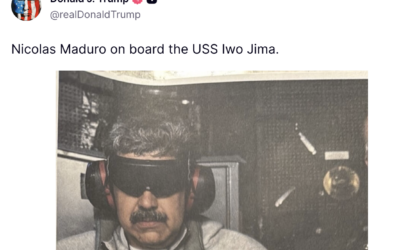At the height of the late Cold War period, Andrew Cockburn wrote The Threat, a book that explored the bear cave of assumed Soviet military dominance. Challenging the narrative of Soviet supremacy—the belief that the Red Bear not only had greater numbers in their favor but also technological marvels that were capable of ensuring swift victory in time of war—Cockburn exposed myths that had been invented: a perceived supremacy that helped justify NATO, the Pentagon’s spending sprees, and a military-industrial complicated nation state that continues to grow long after the Berlin Wall fell and the Soviet Union collapsed.
Today, many of the same arguments are being made. If not for Russia, it is China, Iran, or even North Korea. It seems the threat is always near and the solution is to grow the military budget and play the “Great Game” with the planet and even into outer space. The existence of such a threat justifies an aggressive foreign policy and the need for hegemony, the world over.
Criticisms of Soviet doctrinal weaknesses, flaws in their weapon systems, and the contrast between U.S. technology and the more crude Soviet stock were easy to make by the 1990s. After the 1991 U.S.-led coalition blitz of the Iraqi military (themselves heavily reliant on Soviet hardware) it was a known reality. The disaster of the Soviet expedition into Afghanistan, which at the time seemed lengthy although eleven years shorter than the U.S. experience, ended in failure. By the bloody war in Chechnya, where the Russian Federation was fighting with Soviet era weapons against a determined insurgency, the Russian Bear seemed flawed. In 1983, such a perspective was not so apparent.
In more recent times, perhaps in part to online games such as World of Tanks, War Thunder and Armoured Warfare, there is a claimed Russian tech bias. Certain weapon systems have favorable characteristics which in turn has helped to perpetuate an already established meme that Russian hardware is strong and low cost. The fixation with on-paper data that doesn’t necessarily translate into real world outcomes has become the domain of casual and paid experts. Factors such as effective range, armor thickness, gun calibres, and so on become the academic squabbling points of historians and memers alike. Other realities such as crew comfort, serviceability or build quality are ignored by those who observe war like a horny voyeur. Many modern experts have in many cases invented a passion for modern Russian weapon systems, that despite a vastly limited budget are in some way superior to other nations kit, as they did in the Soviet era.
Long before the Cold War, Russia existed as a menace to the British Empire. The first Great Game was played to keep the oriental Russians in check, to deny them influence in Persia and Afghanistan but especially India. The terrible Crimean War in 1854 was the outcome of such a game. In modern times the existence of a Russian threat keeps the United States in Europe, just as such a threat kept Britain in the Orient. Empires need rivals, even if the rivals turn out to be let downs. The Russian military has a reputation and much of it arose from its victory in the Great Patriotic War against Nazi Germany.
Enter the T-34
The Soviet Union’s T-34 was the best tank of World War II according to many. It had all of the right elements; a decent gun, sloped and thick armorr, mobility, and speed. On paper it was a world beater and in large numbers it was unstoppable, a true war winner. In reality it was of inconsistent quality and usually of poor manufacturing standards. The metallurgy was varied, often shattering when hit. The transmission was horrible making it impossible for some drivers to leave first gear. Most tanks lacked radios and were almost blind and prone to break downs. The ammunition was of mixed grade and could be in short supply. On paper those factors aren’t considered, but for the crews they were ever apparent.
After the war, the defeated Wehrmacht officers who had become celebrities in the West used the T-34 and the myths of other Soviet rugged weapons as proof that they could have won the war, if not for impossible numbers of man and machines that overwhelmed the Nazi military. The T-34 did become a good tank, just not as great as certain mythologies required it to be.
In the post-war period, Wehrmacht officers helped to influence NATO and U.S. war planners. It was in their self interest to do so. The perception of the unstoppable Soviet war machine was matured by the belief that it was also one of scientific sophistication. The missile and bomber gap joined the ranks of tank divisions that could overwhelm the West. The Soviets did, after all, put a man and satellite into space first. To defeat such a threat, the U.S. and its allies would need to spend big and invest in all sorts of counter-measures.
The juggernaut of the Soviet military that defeated Nazi Germany was also fed thousands of tanks, trucks, jeeps, fuels and materials by their Western allies, an often ignored fact. The T-34 was a good tank (sometimes) but like most Soviet weapons the quality and serviceability varied. It turns out that the Allies did have a reliable, crew friendly, mass produced, relatively cheap war winning tank, the U.S. M4 Sherman.
Foxbats and BMPs
The sleek looking and super fast Soviet MiG-25 Foxbat is an impressive aircraft. Built as a response to supersonic U.S. intercontinental bombers, namely the ill-fated XB-70, in theory the new U.S. bomber was able to travel at Mach 3. The Foxbat was built to fly faster and higher than any other military aircraft. It would need to if it was going to intercept fleets of supersonic bombers. The XB-70 never entered service. ICBMs were a cheaper and more effective means of delivering nuclear destruction to a city full of people. Western observers at a 1967 airshow first glimpsed the Foxbat. It was speculated to be highly manoeuvrable, made of lightweight alloys, and almost impossible to beat. In 1971, Israeli F-4 Phantom’s were unable to intercept and catch a Soviet MiG-25 that was flying high above the Sinai Desert. The threat seemed real.
Suddenly from out of the sky a defecting Soviet pilot landed his MiG-25 in Japan, gifting the West with the plane to tear apart and a pilot to debrief. Though history has shown it to be a fascinating machine, it is was not the unstoppable wonder weapon as feared. Made of heavy stainless steel and not lightweight titanium and far from maneuverable, the engines could not sustain high speeds without damage. It possessing a powerful radar with no look down capabilities, meaning it was unable to track low flying targets, important for a high altitude fighter. The Foxbat was suddenly mortal.
The belief that such an aircraft was unstoppable suited both sides. It was a deterrent for the Soviets and for the Pentagon it ensured more funding was needed. When the U.S. entered their new B-1 bomber into service, it was switched to a low level penetrator mission. So scores of MiG-25’s built were awkwardly re-designated to other roles that they were not intended for.
When the Soviet Infantry Fighting Vehicle, the BMP-1 first crawled onto the scene it was an impressive weapon on paper and as a concept. It had a low velocity 73-mm main gun, anti-tank missiles, firing ports for the infantry that it carried, NBC (Nuclear Biological Chemical) protection and an autoloader that mechanically fed ammunition to the gun. It turned out inside the vehicle it was cramped, the main gun was inaccurate, the firing ports weakened the hulls integrity, the autoloader in earlier variants could eat crew members arms plus was slower than manual loading and the anti-tank missile was hard to aim and guide. The downgraded export versions sold to Soviet client states, many captured in large amounts by the Israelis, also revealed a less than desirable machine.
Many other weapon systems existed that seemed impressive on paper. It is at the production and maintenance level that a lot of the issues occur. An almost complete disregard for crew comfort which leads to fatigue and poor battle performance, the perception of durable low technology systems that can overwhelm and endure a modern enemy is fine so long as the crew are well trained, supplied and with good communications. The low tech mentality seems to be contrasted by the investment of untried technologies which require a lot of up keep and research or as often was the case, a need by the Soviet government to field a version of something before the West. For example the Tu-144 versus the Concorde, where perception and propaganda mattered more than reliability and actual utility of the aircraft.
Big Bad Bear and Ukraine
The fantasy has always been that the Soviet Union and modern day Russia is geared and poised for offensive operations, to swallow up Western Europe and perhaps the world. The recent war in Ukraine from the Russian perspective is very much defensive, a reaction to events. On a tactical level they have stumbled and fumbled, though it seems that the aim is not full invasion or occupation. The limited invasion has not been a cakewalk for Russia. The Russian military is finding itself out numbered in Ukraine and has underestimated the Ukrainian response to their presence. The question has been, “why aren’t they greeting us with flowers?” Why, indeed comrade invader.
The durable tanks, guidance systems, drones, and hyper-sonic technology don’t really matter that much when you start running out of men, trucks, and fuel. The image of Russian vehicles driving with flat tires, the rumor that buses and lorries have been nationalized by the government and footage of civil dump and garbage trucks carrying soldiers to the front line all show the importance of logistical planning, something that the Russians have been deficit in. When on the offensive, transport vehicles, spare parts, lubricants, fuel, and supplies matter a lot. Perhaps it has been an otherwise defensive mentality and the belief in certain myths that has led some flaws in Russian operations. Cheap to develop and build weapons come with the promise of large numbers for a better cost, ignoring the cost of servicing, supplying, and crewing. Often these costs in the end are far greater. One can’t simply mass produce skilled and motivated human beings like they can machines.
The Russian air force has also performed poorly. With pilots that have had to take on additional work in airlines to make ends meet and to keep their flight hours up, seemingly part-time combat fliers now fly in war. Many of the pilots have rarely trained in close air support or ground attack missions, and instead seem to be more focused on air defence and interception missions. The attrition on man and machine has been high for the Russian Air Force. Machines are easier to replace than experienced and well trained pilots, this was something that the Japanese and Germans especially learned in the second world war. Russia in just over a month is now relearning such economics.
Military Industrial Comrades
There exists a belief that only the U.S. military-industrial complex is corrupt and leads to expensive and at times unwanted weapon systems. It was worse in the Soviet Union and it is likely just as bad in modern Russia and even China. Within the U.S. there is at least transparency and party political bickering that allows for awareness and criticism of Pentagon expenditure. Generally speaking the U.S., as crazy as it seems, gets better value for money than what they did in the Soviet Union and perhaps even in modern Russia. Corruption is rampant in a nation state that has very little wealth and relies on selling of military relics from when it was an apparent communist super power. Many of the modern weapons are based on designs from that period or are essentially newer versions of such. The next generation Russian T-14 tank, SU-57 stealth fighter or Lider-class destroyer may as well be the M-247 DIVAD, USS Zumwalt, or even the F-35 for that matter, but the U.S. can absorb the costs of such projects and boondoggles.
As was the case when Cockburn wrote The Threat the Russian soldier is often underpaid, unhappy, and under trained. In the post-Soviet era this is still much the same for some, leading to theft of equipment to be sold on the black market, drinking cleaning alcohol, and desertion. Such culture has remained in some modern units. In Ukraine outside observers have noted at times little coordination, tanks seemingly entering urban areas without infantry support, pilots requiring hand written coordinates to enter into ancient navigation systems and many of the elite units wiped out along with several generals. As Russian tanks dig into fixed positions, the crews flying drones above their positions watch remotely down, observing where Ukrainian missiles are coming from, returning fire accordingly. It has become a war where small units and in many instances individuals adapt, making do despite what their governments supply them with or even require of them.
Russia has lots of tanks, as was the case then too, many kept in ancient reserve and slowly modernized (if at all). The Russian government just doesn’t have the resources to upgrade much of its Cold War era weapon systems. The real threat is the weapons of mass murder that Russia has. It is not with hydrogen bombs that the Russian army will push through the Fulda Gap with; instead they exist in the hope of deterring the West from invading, a very real paranoia given the last few centuries of history. A clumsy and aggressive foreign policy of one empire that rests far away on another continent, that has become so entitled in its ability to influence affairs the world over, is the threat not to just Russia but all. NATO expansion and the pre-war meddling in Ukraine has been a dangerous sabre dance that involves nukes, and for what gain? To play another Great Game? To make money for government and corporate goons? To satisfy national imperial hubris? Containment?
As was the case before, when and after Andrew Cockburn wrote The Threat there was a need to oversell the strengths and capabilities of Soviet (now Russian) systems and their military. The U.S. defense spending is immense, the American psyche for war is unmatched, an exceptionalism based on an otherworldly destiny to interfere, check and fight when it wishes. Super enemies are required to validate spending and actions, to rationalize the presence abroad and the existence of an incredible military machine. No matter how often the threat reveals itself to be underwhelming, overblown, and even inept those charged with countering it shall always find another or even in time the same old one. Cold War 2.0 is now, and not much has changed except that it seems wisdom has been cancelled.
































